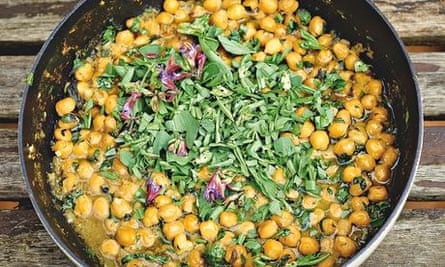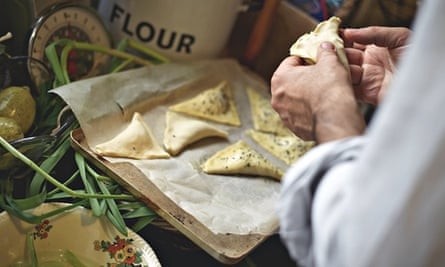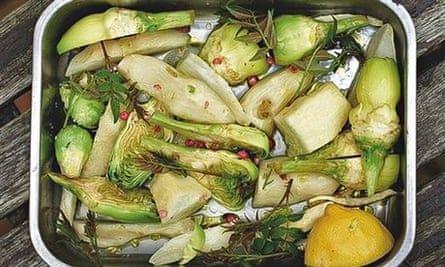Alys on Yotam
I am good at growing greens. Sometimes I am only good at growing greens. My husband calls this the leaf and twigs stage, which is shorthand for, "We're having kale for supper again." Kale, spring greens, leafy greens, bitter greens – it's all a bit green for too much of my year. I've come to the end of my repertoire of what to do with them, and chopping them up so finely you can't notice them isn't going down well at all.
I need help, and it's my good fortune that the very best help is nearby. It started off as a bit of a fantasy to ask Yotam Ottolenghi to make something of an English garden. What would the man with the most diverse store cupboard in the country do if confronted with my modest harvest? But then we talked, he said yes, and now he's at my front door. He had train trouble, he's hungry and I've just broken it to him that slugs ate most of the garden. But none of this fazes him.
Yotam puts down his shopping bags, looks out at the garden and rapidly starts discussing ingredients. He wants to cook three things, maybe four. Four things from a garden that's under the worst slug siege in years? I have a one-meal-a-day-from-the-garden rule, not four. As we head to the allotment, I try to hide my panic. I also notice that Yotam stuffed a cinnamon roll into his mouth as we left the house, and he's making appreciative noises. Perhaps he'll be full from that, and happy with only the one dish?
At the allotment, I learn how much Yotam likes to eat. I pick broad bean tops for him to try. The beans are late, partly because the bees have been robbing the flowers, and I have a lot of tops, so I cross my fingers that he likes them. He does, and starts rapidly harvesting. Then I offer him a rare kale from Spain, an asparagus kale, a little orache, various mints and sages. I soon realise that you could hand him just about anything and he'd eat it, so I start to have fun: I feed him herbs, flowers, more kales and then I stuff him full of weeds. He declares sow thistles as good as radicchio and does some free weeding.
We eat Szechuan pepper leaves, too. The old ones, he decides, are reminiscent of curry leaves, and the young ones will go with the artichokes. I nudge him off a cabbage he's standing on and confuse him with tales of perennialising garlic. At this time of year, I've often finished all the garlic from my stores, so we eat a lot of wet or green garlic (tender young bulbs where the papery casing hasn't formed), and lots of scapes (non-flowering stalks of young garlic plants). These are one of the joys of early summer, so we harvest some of them, too.
We soon have a groaning tray of greens, garlic, flowers and herbs, plus a cluster of baby artichokes – one of the treats of growing your own is that you can pick them before the choke is fully formed; you can eat these whole. We add more artichokes from the garden (OK, I have a lot of artichokes, but they are the best crossover plant: architectural, beautiful and edible) and various heritage kales (mostly daubenton perennials that live for five or more years). I force sweet cicely root on to the menu, too. (Let it self-seed and harvest the young roots when no more than two years old, otherwise peeling is a bit fiddly. It's delicious.)
My hamburg parsley is a disappointing size because I spent all winter eating its leaves as a parsley substitute. We improvise with out-of-season jerusalem artichokes. It says a lot about quite how rampant these plants are that you can still find tubers even after you thought you dug them all up. Finally, as a treat, I let Yotam harvest a tray of salsola soda (agretti).
And then to the kitchen. Yotam turned up with a store cupboard's worth of extras: jars of Middle Eastern herbs and spices, tubs of this and that, vinegars, molasses and the fanciest garlic crusher I have seen. Few were used, though I can't work out whether that's because I teased him about the amount of back-up he'd brought or because my kales are so delicious, they don't need extras.
I did learn the following, though: cheese tempers bitter greens in a marvellous way; sherry makes everything taste sophisticated and rich; I must grow more dill; tahini and yoghurt is the perfect marriage for herbs; and old jerusalem artichokes are a revelation in the hands of a fine cook.
If I were to say anything about Yotam's ludicrously long ingredient lists, I'd say this: they are a reflection of the man. They are generous, because he is. When you can have an extra mouthful, another layer of flavour or four kales rather than one, why wouldn't you?

Yotam on Alys
You can take the boy out of his town, the phrase goes, but you can't take the town out of the boy. Not in my case: you'll never take me out of my town. Well, not easily, anyway. To drag me away from London, you'd need to entice me with an offer I can't possibly refuse – a Mediterranean island-hop, perhaps? A week in a cool riad in the heart of Marrakech? I am now a London boy at heart, and have always been a devout townie inside and out, so I feel slightly breathless without an urban setting.
You can probably picture, then, my sense of unease when I said goodbye to my friend Cornelia, with whom I was having breakfast, promised her I'd do my best not to get a nosebleed, and set out on the train from Euston to visit Alys at her allotment in Highgate Park, Birmingham. Foolishly, I ended up on a slow train, which stopped endlessly along the way and made this Midlands city seem even farther from my home turf.
As so often, though, it turned out there was no nosebleed and no trauma: very little mud stuck to my designer boots, no nettle stung me, it didn't rain cats and dogs (a light, London-style drizzle was the worst Birmingham could manage). In fact, Alys's allotment seemed the most unterrifying place I could possibly have landed in. With her group of adorable friends and neighbours, her dog wagging its tail merrily and a general sense of a warm, close-knit community, focused on growing and cooking food together, I'd have happily stayed in Highgate Park much, much longer.
Chickpea stew with wet garlic, sage flowers and broad bean tops

I had never used broad bean tops before, so am indebted to Alys for introducing me to them. Here, they balance the intensity of the long-cooked stew and bring some welcome freshness. Sage flowers were another revelation: apart from looking beautiful, they taste of sage but with none of the associated bitterness. Non-vegetarians can add some extra depth to the mix by throwing in two chopped anchovy fillets with the sherry. Serves six.
75ml olive oil
2 medium onions, peeled and roughly chopped
3 cloves garlic – wet or normal – peeled (if dried) and crushed fine
1 tbsp cumin seeds, crushed
2 tsp fresh rosemary, leaves picked and finely chopped
1½ tbsp sage leaves, finely chopped, plus a few flowers, if you have them
300ml dry sherry
1 litre vegetable stock
½ tsp caster sugar
Salt and freshly ground black pepper
480g cooked chickpeas (tinned are fine)
300g bulgur wheat
¾ tsp ground allspice
160g broad bean tops, pea shoots or baby spinach
For the parsley sauce
30g parsley, roughly chopped
120g Greek yoghurt
100g tahini paste
1 garlic clove, peeled and crushed
1½ tbsp lemon juice
Put all the sauce ingredients in the small bowl of a food processor, add 120ml water and a quarter-teaspoon of salt, and blitz smooth. Set aside.
Put two tablespoons of oil in a big sauté pan and on a medium-high heat fry the onion, garlic and cumin for 10 minutes, until the onion starts to colour and soften. Add the rosemary and half the sage leaves, and cook for two minutes, stirring once or twice. Pour in the sherry and cook for three minutes, to reduce a little, then add half the stock, 700ml water, the sugar, three-quarters of a teaspoon of salt and a grind of pepper. Return to a simmer, add the chickpeas, turn the heat to medium-low and cook for an hour, until the chickpeas are soft and the sauce has thickened. Use a potato masher to crush a quarter of the chickpeas.
Meanwhile, put the bulgur in a medium saucepan for which you have a lid and add the remaining stock, 200ml water, the allspice, the remaining oil and a teaspoon of salt. Bring to a boil, then cover, turn to a simmer and cook for six to seven minutes. Remove from the heat and set aside, covered, for 15 minutes, until all the liquid has evaporated and the bulgur is cooked through.
Just before serving the stew, stir in the remaining sage leaves (plus flowers, if you have them) and the broad bean tops; you may need to add a little water, too, if the crushed chickpeas have made it too thick. Stir through for a minute, just to warm up, divide the warm bulgur between the plates and spoon the stew on top. Serve at once with a generous dollop of parsley sauce.
Multi kale borek

These little pies are ideal picnic fare. If you want to prepare well in advance, they can be frozen pre-baking. Makes 12 pies, to serve six.
1 tbsp olive oil
2 large garlic cloves, peeled and sliced thin
200g kale, shredded
200g baby spinach
1 tbsp finely grated lemon zest
1 tbsp lemon juice
1 tbsp za'atar
2 eggs, beaten
75g ricotta
100g mature cheddar, grated
Salt and black pepper
100g feta, broken into 1cm chunks
Plain flour, for dusting
500g block puff pastry
2 tbsp mixed white and black sesame seeds (or only white)
Heat the oven to 190C/375F/gas mark 5. Put a large sauté pan for which you have a lid on a medium-high heat. Add the oil and, once hot, the garlic. Fry for a minute or two, until golden brown, then lift the garlic from the pan. Add the kale and three tablespoons of water, cover and cook for three minutes. Add the spinach and cook for three minutes, until wilted. Remove the pan from the heat and set aside to cool, then transfer the leaves to a clean tea towel, gathering up the sides and squeezing out as much liquid as possible. Roughly chop the leaves and put them in a large bowl with the garlic, lemon zest, lemon juice, za'atar, one egg, ricotta, cheddar, a quarter-teaspoon of salt and a grind of black pepper. Fold in the feta and refrigerate.
Divide the pastry in two and on a lightly floured surface roll out each half to a 26cm x 39cm rectangle that's 2mm thick. Trim the edges, then cut each rectangle into six squares. Spoon two tablespoons of the filling into the middle of each square. Brush the edges with a little of the remaining egg and fold one corner over another to form a little triangular parcel. Pinch together to seal, then put on a parchment-lined baking tray. Repeat with the rest of the pastry and filling, and space the parcels evenly on the tray. Brush with egg, sprinkle with sesame seeds and chill for 10 minutes. Bake for 25-30 minutes, until cooked and golden brown. Set aside for five minutes and serve warm or at room temperature.
Braised baby artichokes with salsola soda and Szechuan pepper

The smaller the artichoke, the less fussy the preparation: once you've removed the tough outer leaves with your hands, trim the tops off the remaining leaves with a serrated knife. Then all you have to do is clean the artichoke, cutting off any rough ends before cutting in half vertically and removing the choke; rub immediately with lemon juice to prevent discoloration. Parsley root, which is fantastically nutty, is almost impossible to buy in the UK – it's one of those ingredients you have to grow yourself. Alys had only a few tiny ones, so I made up the difference with jerusalem artichoke and sweet cicely root. You're also unlikely to find salsola soda (aka agretti or barba di frate) at the local shops – this is a succulent shrub with a bit of crunch and mild saltiness; samphire makes a good substitute. Serves four.
10 baby artichokes
2 tbsp lemon juice, plus 2 tsp extra
500g parsley root or jerusalem artichokes, scrubbed, peeled and cut into 3cm chunks
1 tsp pink peppercorns
1 tsp black peppercorns
1 handful small Szechuan pepper leaves (or 1 tsp Szechuan peppercorns)
3 tbsp olive oil
Salt
1 large garlic clove, peeled and crushed
120g salsola soda (or samphire)
60g baby spinach leaves
Heat the oven to 160C/320F/gas mark 2½. Prepare the artichokes as in the introduction and put the cleaned halves in a bowl of water with a good tablespoon of lemon juice, to prevent them discolouring.
Drain the artichokes and put them in a large bowl with the jerusalem artichokes, a tablespoon more of lemon juice, all the peppercorns and the Szechuan pepper leaves, two tablespoons of oil and a quarter-teaspoon of salt. Pour over 200ml water, mix everything together, then tip into a large, high-sided 20cm x 20cm baking tray – the liquid should come about a third of the way up the sides of the artichokes, so add a little extra water if need be. Cover the tray tightly with tinfoil and roast for 45-60 minutes, until all the vegetables are tender. Lift off the foil and drain the remaining liquid in the tray into a small saucepan: you should have about 200ml. Put this on a high heat and boil for seven minutes, until it reduces down and only three tablespoons of liquid remain. Pour into a large serving bowl, stir in the cooked vegetables and set aside.
Put the remaining tablespoon of oil in a large frying pan on a medium-high heat. Add the garlic and cook for 30 seconds. Add the salsola, cook for a minute, then tip over the vegetables. (If you're using samphire and it isn't very salty, add an extra quarter-teaspoon of salt.) Stir in the spinach, add a final squeeze of lemon and serve.

Comments (…)
Sign in or create your Guardian account to join the discussion